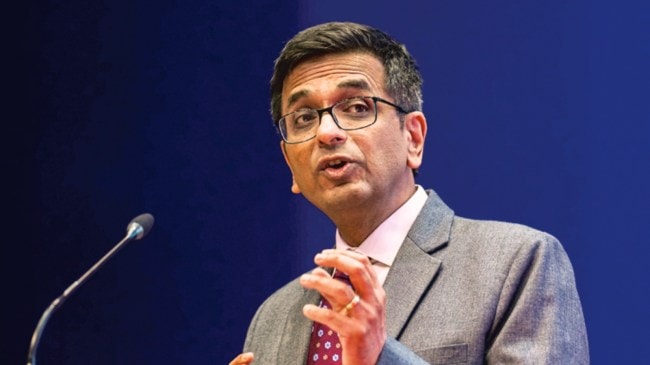Opinion Even at cost of controversy, judicial voice in public sphere is good for democracy
When people know more about judges — their ideas, competence, and perspectives on national issues — it enhances public confidence in the legal system
 The ecosystem has evolved to become more tolerant and appreciative of judicial voices expressed beyond the courtroom.
The ecosystem has evolved to become more tolerant and appreciative of judicial voices expressed beyond the courtroom.
Some recent conversations of former Chief Justice of India D Y Chandrachud in the media created a furore, reigniting an old debate: To what extent should judges engage with the media — during or after their tenure — and where must the line be drawn?
Communication between judges, the media, and similar channels has been the focus of recent research. In The Shadow of the Court, Gabrielle Appleby and Alysia Blackham note that soft guidelines and advisory opinions are needed to help retired judges navigate appropriate boundaries in public discourse. In Judicial Strictures: Liberty of Judicial Expressions and Restraints, Trilok Nath Arora said that some judges are prone to make carping remarks about individuals and organisations during hearings or in their judgments, which then make headlines in the media.
Courts, such as the European Court of Justice and top courts in various countries, issue structured press releases and explanatory notes to clearly inform legal professionals and the public, ensuring accessibility and judicial neutrality. There is an increasing global emphasis on judicial transparency and structured engagement with the media within frameworks designed to preserve both judicial independence and public confidence. The ongoing challenge lies in achieving transparency while mitigating the risks associated with misinformation and improper influences.
Two schools of thought are evident in this regard. The first argues that judges should remain detached from the media, especially while in office, and must also avoid being seen in proximity to political leaders, whether in the government or the Opposition. According to this view, judicial dignity demands distance, discretion and silence.
The second school of thought believes otherwise and is more optimistic. It asserts that there is a growing need for judges to be open and engaged, particularly after retirement. Once they are no longer in active office, their reflections and insights enrich public discourse and promote transparency. Speaking to the media, within this view, should not be seen as inappropriate, especially when it contributes to informed democratic dialogue.
There is, of course, a strong opinion — and not without reason — that judges, being part of benches deciding sensitive matters, must exercise the utmost restraint in making public statements. Their remarks are vulnerable to misquotations or distortions, especially on social media, where they can be amplified and twisted into larger controversies. Many informed citizens and legal stakeholders share this cautious approach; however, history shows that excessive closedness within the judicial system has its own pitfalls. We recall the unprecedented press conference held some years ago by four of the Supreme Court’s senior-most judges — a moment that underscored the need for transparency within the institution. However, in the last decade, this trend has notably shifted, with judges beginning to participate more freely in discussions, conferences, and seminars.
There are identifiable reasons behind this liberalisation in judicial circles. One major factor is the emergence of dynamic law schools that regularly organise thought-provoking conferences, policy debates and academic forums, inviting judges to share their views on complex legal and constitutional questions. This interaction has bridged the gap between the judiciary and academia. Second, there has been a rise in contextual and analytical reporting on what judges say, not only through judgments but also through their public addresses. These observations are actively discussed across newspapers, opinion articles, social media, and academic circles. Thus, the ecosystem has evolved to become more tolerant and appreciative of judicial voices expressed beyond the courtroom.
It is important to remember that before the 1980s, such a situation hardly existed. The absence of social media limited academic forums, and fewer opportunities for public engagement kept judges largely invisible outside their judgments. Today, however, public scrutiny of judicial opinions — whether in judgments or speeches — is a welcome sign of a progressive judiciary in a liberal constitutional democracy. Citizens have a legitimate expectation to know the judiciary’s perspective on pressing issues such as pendency, judicial reforms, appointments and systemic delays. Other organs of the state, such as the legislature, executive, police, prosecution, prison authorities, and the Bar, already speak openly on such matters. In this light, the judiciary’s participation in public dialogue enriches the discourse.
Hence, even at the cost of some occasional controversy, the judicial voice in the public sphere should be seen as a healthy development for a democracy like India, which follows an adversarial legal system. Over the past two decades, judges have significantly contributed to legal reforms, research, and education through their speeches and interactions. Fears of misquotation or overinterpretation should not stifle their experience sharing.
Of course, extreme positions should be avoided. Judges must refrain from commenting on pending cases or judgments under consideration, as such comments could compromise judicial propriety. However, after retirement, they should have the liberty to share their experiences and reflections without restrictions or censorship, free from the fear of misinterpretation. This will strengthen legal education and inspire the legal profession.
Similarly, interactions between judges and leaders from the executive or political spheres should not always be viewed with suspicion. Constructive dialogue across institutions can foster mutual understanding and generate ideas that are beneficial for governance and justice. Collectively, these developments reflect a new spirit of openness and transparency in the judiciary system. When people know more about judges — their ideas, competence, and perspectives on national issues — it enhances public confidence in the legal system. For a democracy that thrives on informed discourse, such engagement is not only desirable but also indispensable to the evolving idea of justice in modern India.
The writer is Vice Chancellor, National Law University Delhi. Views are personal






